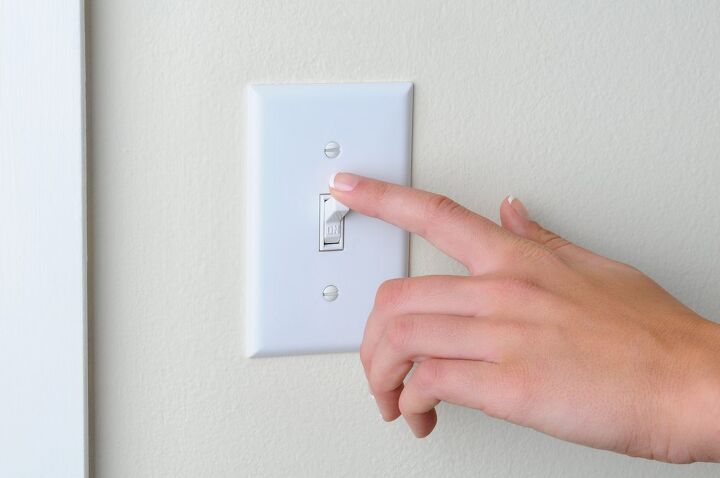Why Your Light Switch Is Buzzing (Possible Causes & Fixes)

We are fortunate in the US to have one of the most stable and dependable electrical systems in the world. Most of us don’t give a thought to coming into a dark room and flipping an almost silent switch to bring light to the darkness. However, it can become disconcerting when a simple light switch starts to buzz.
A buzzing light switch is usually caused by a poor electrical connection or a problem with the switch contacts. As the electrical current flows through the bad connection, the flow of electricity may arc across the bad connection. This can cause vibrations which result in the buzz. The light switch remains safe but should be checked and replaced if necessary.
What’s causing the current to arc, though? Why wasn’t this happening before? To understand what’s going on behind the cover, we need a basic overview of how your lights turn on when you flip the switch.
Do You Need to Hire an Electrician?
Get free, zero-commitment quotes from pro contractors near you.

How Power Gets To Your Lights
A switch controls the flow of power within a circuit. A circuit is a loop of wiring that facilitates the flow of electricity.
Think about the electrical panel in your basement. The panel contains several circuit breakers, each of which controls the flow of power to a certain section of your house or specific appliances. Each breaker should be labeled. For example, one would read “Kitchen Lights” while another may read “Attic A/C Unit.”
Suppose that the breaker to your kitchen lights is turned to the “ON” position. That means the breaker is allowing electrical current to travel from the panel to the kitchen. Remember, all a circuit does is allow electricity to travel from its source, through the fixtures within the circuit, and then back to the source.
The current travels through a cable containing three wires:
- Hot wire: Delivers electrical current from the source to the fixture. It’s covered with black insulation.
- Neutral wire: Delivers electrical current from the fixture to the source. It’s covered with white insulation.
- Ground wire: Doesn’t carry any electrical current under normal operating conditions. It’s either covered with green insulation or bare copper.
The role of the ground wire is to carry electrical current in the event the circuit between the hot wire and the neutral wire is interrupted. It ensures the electrical current can flow back to its source (in this case, the breaker). Note: A neutral and ground wire should never be connected.
How Your Light Switch Works
Let’s build on the previous example. Just because the breaker allows current to run to the kitchen lights, doesn’t mean the lights themselves are turned on. The switches control whether the electrical current travels up to the lights.
For the sake of argument, let’s assume the switch you’re talking about is a single-pole (ON/OFF) switch. You flip it to the “ON” position and the lights go on. Flip to the “OFF” position, and they go off. Simple.
A single-pole switch is designed for only one hot wire connection. If it’s a single-pole, single-throw (SPST) switch, the switch will only connect to a single outgoing wire: In this case, the wire traveling to the light.
Each switch has a spring-loaded metal gate that opens and closes the circuit leading to the outgoing wire. When the switch is in the “OFF” position, the gate is open, allowing current to flow from the switch back to the breaker. When the switch is “ON,” the gate is closed, permitting electricity to flow through the outgoing wire, through the light’s element, and then back to the switch.
An SPST switch has three screws: Two for hot connections and one for the ground connection. The SPST sits inside a box through which two cables are connected. Each cable has a hot, neutral and ground. One cable travels from the source to the switch, while the other travels from the switch to the light.
Each cable’s hot wire connects to the switch itself. Each cable’s neutral wire is spliced together – same with the ground wires. However, a third ground connection from the splice travels to the ground nut on the switch.
What Would Cause The Light Switch To Buzz?
Knowing how power is getting to the switch and traveling to the light, why would the power arc over the switch itself?
Think about the sound: Was it always there? If so, it could be as simple as loose screw terminals on the switch itself. That means the hot wires are loose, so the electrical current is trying to jump between them. Here’s how you check it.
Checking For Loose Screws On A Light Switch
The first thing you have to do is find the circuit to which the switch belongs. Get someone to help you with this. They can confirm whether you’ve shut down power to the switch from the panel.
Get your buddy on the phone, and walk over to the electric panel. If the breakers aren’t labeled, start flipping them to the “OFF” position, asking your friend if the light turns on or off. Once they confirm the light has turned off, you’ve found the correct breaker. Leave it off.
For the next step, you’ll need a few tools:
- A voltage tester.
- An 11-in-1 or 6-in-1 screwdriver (make sure it comes with a Phillips head bit and a flat head).
- A pair of wire strippers.
Unscrew the light switch cover to expose the switch. You’ll see the two hot-wire contacts connected to it. Before touching the wires, turn the voltage tester on, and place the end of it to the cable. If the light on the tester stays green, you’re safe – no power is going to it. If the light on the tester turns red, power is still flowing to the switch. Don’t touch it.
If you got the green light (literally), you can touch the wires connected to the switch. If they’re loose, simply tighten the screws until the wires are firmly secured. You may need to cut the hot wires, strip the insulation, and then reconnect them.
Check all the other connections for the neutral and ground wires. Make sure the wire nuts are wound firmly.
Now, place the cover back over the switch. Leave your friend by the switch and turn on the breaker you turned off earlier. Give him a ring and ask him if he or she can hear the buzzing sound. If it’s gone, you’ve solved the problem. If not, then you need to replace the switch.
Replacing A Light Switch
At this point, it’s recommended that you call an electrician to change the switch out. If you have experience changing out switches by yourself, then feel free to do so, but it’s always recommended to have a licensed professional take on the work. Safety’s been drilled into their work habits.
Do You Need to Hire an Electrician?
Get free, zero-commitment quotes from pro contractors near you.

Related Questions
What If The Switch That’s Buzzing Has A Dimmer?
If the switch your concerned about has a dimmer, then the buzzing sound is (likely) normal. It depends on how loud the buzzing sound really is.If all you hear is a light humming, then you don’t have anything to worry about. Here’s what’s happening: the dimmer is shutting the circuit to the light bulb off every time the electrical current changes direction. This is possible because of “alternating current” (AC). AC constantly changes electricity’s direction of flow. When the direction changes, the dimmer shuts off the circuit.If the buzzing is any more than a light hum, then an electrician should diagnose the issue – especially if the buzzing noise is audible from across the room.
Can Buzzing Damage The Light Switch?
Yes. Remember, when the buzzing’s occurring, the current is trying to jump between the terminals on the switch itself. In best-case scenarios, this can cause minor heat damage to the switch itself. Worst case: it starts an electrical fire. This is especially true if the hot wires touch each other.Find out what you can do if your garbage disposal is humming.
What Is a Three-Way Switch?
A three-way switch controls the flow of electricity through a circuit from two different locations. For example, suppose you have two switches that control the lights in your bedroom. Just before bed, you turn on the one by the door. After you crawl into bed, you keep the lights on to read. Once you’re ready for sleep, you can flip the switch by your nightstand instead of getting out of bed to turn off the lights.You’ll notice several differences between a three-way switch and a single-pole switch:
- A three-way switch doesn’t have an “ON” or “OFF” label.
- Whereas a single-pole switch has three screw terminals, a three-way switch as four: one ground, one “com” screw, and two “traveler” screw terminals.
Think of a three-way switch as a single-pole, double-throw (SPDT) switch. The pole can establish contact between one of the switch’s two traveler wires. For instance, if the poles on both switches are touching the “traveler A” terminals, the light will turn on.
Three-way switches are great options if you’re in the process of remodeling your house. Think of areas where you think it’d be convenient to have two switches control the same light fixtures. Ask the electrician’s opinion.
Don’t undertake any major rewiring projects without the aid of a licensed professional. If you want to learn more about the trade, ask the electrician if you can assist them. A willingness to learn will impress them, and the experience will allow you to remedy any issues you find down the road.
Related Articles

We are a team of passionate homeowners, home improvement pros, and DIY enthusiasts who enjoy sharing home improvement, housekeeping, decorating, and more with other homeowners! Whether you're looking for a step-by-step guide on fixing an appliance or the cost of installing a fence, we've here to help.
More by Upgraded Home Team
























![10 Most Dangerous Neighborhoods in Baltimore [Updated]](https://cdn-fastly.upgradedhome.com/media/2023/07/31/9075655/10-most-dangerous-neighborhoods-in-baltimore-updated.jpg?size=350x220)


